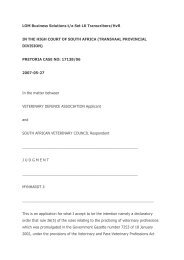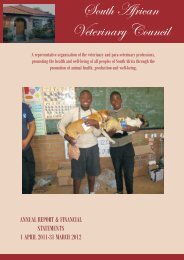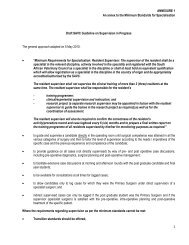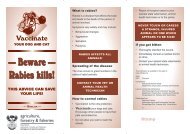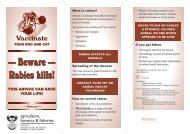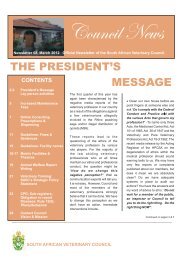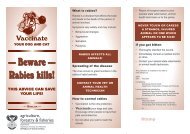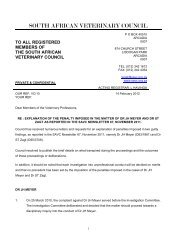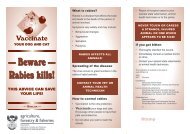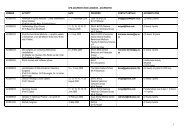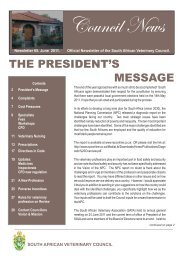Rabies Guide 2010.pdf - the South African Veterinary Council
Rabies Guide 2010.pdf - the South African Veterinary Council
Rabies Guide 2010.pdf - the South African Veterinary Council
Create successful ePaper yourself
Turn your PDF publications into a flip-book with our unique Google optimized e-Paper software.
Human antirabies immunoglobulin<br />
The administration of antirabies immunoglobulin<br />
(RIG) complements rabies vaccination in situations<br />
where viral transmission may have occurred, as<br />
production of vaccine–induced neutralising antibodies<br />
take seven to 10 days after vaccination. RIG is safe<br />
and provides rapid passive immunity that persists<br />
with a half-life of approximately three weeks. 111,112<br />
The human RIG currently used in <strong>South</strong> Africa is<br />
produced by fractionation of pooled serum from<br />
immunised persons. The introduction of human RIG<br />
proved a valuable replacement to <strong>the</strong> previously used<br />
antirabies serum prepared in horses. Although <strong>the</strong><br />
latter was effective and is still used in many developing<br />
countries, it may induce serum sickness. To ensure<br />
potency, it is essential that RIG be maintained<br />
between 2 and 8°C during handling and storage. All<br />
patients who have received RIG should be observed<br />
for an hour <strong>the</strong>reafter. An emergency pack for treating<br />
anaphylaxis should be available.<br />
The dosage of human RIG currently available in<br />
<strong>South</strong> Africa is 20 International Units (IU) per kg<br />
body-mass. 73 RIG is supplied in 2 ml ampoules with<br />
a virus-neutralising antibody content of 300IU.<br />
Preferably <strong>the</strong> complete dose of RIG should be<br />
infiltrated into <strong>the</strong> depth of <strong>the</strong> wound or tissue<br />
immediately adjacent to <strong>the</strong> wound. Where this<br />
is not anatomically possible, <strong>the</strong> remaining RIG<br />
may be injected intramuscularly into <strong>the</strong> deltoid<br />
muscle. 113 RIG was traditionally administered into<br />
<strong>the</strong> buttocks, but <strong>the</strong>re is evidence of low circulating<br />
rabies neutralising antibodies following RIG injection<br />
into gluteal fat. With multiple wounds, where <strong>the</strong><br />
dose of RIG based on body mass is insufficient to<br />
infiltrate all wounds, <strong>the</strong> dose must be diluted up<br />
to 50% in saline to allow infiltration of all wounds.<br />
Failure to infiltrate all wounds is believed to have<br />
contributed to <strong>the</strong> deaths of a number of children. 114<br />
Local anaes<strong>the</strong>tic agents should not be used to<br />
facilitate RIG administration.<br />
RIG is administered on <strong>the</strong> day of initial patient<br />
presentation, traditionally referred to as day 0, with<br />
<strong>the</strong> first dose of vaccine but at separate injection sites.<br />
This is irrespective of <strong>the</strong> time elapsed since exposure,<br />
which represents a departure from <strong>the</strong> previous<br />
recommendation that RIG should only be given to<br />
patients presenting within a week of exposure. 97 If RIG<br />
is not available when vaccination is initiated, it may<br />
be administered up to day 7 after <strong>the</strong> administration<br />
of <strong>the</strong> first vaccine. RIG administration is not<br />
recommended prior to vaccination, nor is it currently<br />
recommended for individuals who have received<br />
pre-exposure vaccination as it is believed that RIG<br />
may interfere with <strong>the</strong> rapid anamnestic response to<br />
vaccine.<br />
<strong>Rabies</strong> vaccines<br />
<strong>Rabies</strong> vaccine, when given post-exposure, induces<br />
immunity within seven to 10 days. Two cell-culture<br />
vaccines are currently registered for use in <strong>South</strong><br />
Africa, i.e. purified chick embryo cell culture vaccine<br />
(PCECV) and purified Vero-cell rabies vaccine<br />
(PRVR), and are highly purified and inactivated<br />
vaccines that meet <strong>the</strong> WHO potency standard of<br />
greater than or equal to 2,5 IU per dose.<br />
All persons judged to be at high risk for rabies<br />
exposure should be vaccinated, with treatment being<br />
initiated as soon as possible even if <strong>the</strong>re has been<br />
a delay in presentation to <strong>the</strong> health service. The<br />
treatment/prophylaxis schedules presented here are<br />
based on <strong>the</strong> most recent WHO recommendations,<br />
and are valid for <strong>the</strong> cell-culture vaccines registered<br />
in <strong>South</strong> Africa. However, it must be emphasized<br />
that <strong>the</strong> Essen intramuscular regimen is <strong>the</strong> only<br />
recommended schedule and administration route<br />
for <strong>South</strong> Africa, and expert advice should be sought<br />
before using an alternative regimen. The vaccination<br />
schedule may be discontinued if <strong>the</strong> suspected source<br />
animal remains healthy for 10 days after <strong>the</strong> exposure<br />
or if an approved veterinary laboratory reports <strong>the</strong><br />
brain specimen from <strong>the</strong> animal as negative. 41<br />
38



